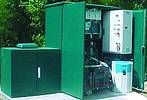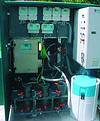
A network of 15 measuring stations has been put into operation in Europe with the help of Endress+Hauser, proving that innovative metrology and GSM communication technology now make it possible to install self-sufficient measuring stations cost-effectively, irrespective of the location.

A total of nine measuring stations were put into operation for early recognition of wastewater load and quality, as well as six measuring stations for monitoring surface water. During selection of the devices, it was important to choose a device family that was as homogeneous as possible, easy to use and operated in the same way. One of the reasons for this, in particular, was to be able to carry out maintenance work quickly and effectively. As a result, it was clear from the start that all devices had to come from one manufacturer and, if possible, from one instrument family. The entire measuring solution was supplied by Endress+Hauser.

The scope of delivery comprised a container, the entire measuring technology, including assemblies, the pipework, the sample conditioning for the analysers and measured value transmission via GSM technology. Power is supplied to the measuring stations by means of the urban power supply system.
In the wastewater, pH, redox, conductivity, turbidity, as well as the spectral absorption coefficient at 254 nm (SAC) to determine the organic load, are measured. In addition, a sampler is also in operation for discontinuous measurement of additional parameters such as COD, BOD and hydrocarbons. The same measurements are made on the surface water - as well as flow and ammonium and nitrate.
In planning the measuring stations, the focus was on measuring principles, which minimise maintenance and the risk of measured value drift. Sensors were preferred which display a high degree of measuring stability and robustness even when used directly in contaminated liquids. For this reason, inductive instead of conductive measuring cells were used for the conductivity. Optical sensors are used instead of analysers with chemical measuring principles for determining the nitrate contents and the organic load. These sensors measure the parameters mentioned directly and without reagents. A conscious decision was made not to use ion-sensitive electrodes, which are susceptible to drift. Sensors with wipers are used for turbidity measurement. The water flow is calculated using non-contact level measurement on the basis of the ultrasonic principle.
Special sample conditioning systems, similar to ultra-filtration with automatic back-rinsing, were integrated for the installed ammonium analysers that are based on a colorimetric measuring principle. This conditioning ensures that the analysers can operate without maintenance outside the normal maintenance intervals. All the sensors are installed in special PVC pots, which are pressurised to 50 kPa. Every parameter has its own flow pot. As a result of the pressurisation, the flow pots are hermetically sealed and the measuring station cannot be flooded. Consequently, safe sample transportation is always ensured.
All the measuring stations have been in operation since October 2003 with positive results. Weekly maintenance work comprises a visual inspection, as well as the cleaning of the electrochemical and optical sensors. The sensors are inspected and, if necessary, recalibrated once a month. It is planned to change the pH and redox electrodes every six months and to send the optical sensors to the factory every three years for thorough inspection and recalibration.
For more information contact Grant Joyce, Endress+Hauser, 011 262 8000, [email protected], www.za.endress.com
| Tel: | +27 11 262 8000 |
| Email: | [email protected] |
| www: | www.endress.com |
| Articles: | More information and articles about Endress+Hauser South Africa |

© Technews Publishing (Pty) Ltd | All Rights Reserved